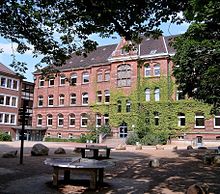Athenaeum Stade
| Athenaeum Stade | |
|---|---|

Rear façade of the Athenaeum
|
|
| Address | |
|
Harsefelder Straße 40 Stade, Lower Saxony Germany |
|
| Coordinates | 53°35′25″N 9°28′20″E / 53.59027°N 9.47222°ECoordinates: 53°35′25″N 9°28′20″E / 53.59027°N 9.47222°E |
| Information | |
| Type | gymnasium |
| Established | 1588 |
| Principal | OStD Wolfgang Horn |
| Vice-principal | StD' Elfriede Schoening |
| Teaching staff | about 120 (as of 2011/12) |
| Enrollment | 1321 (as of January 5, 2015) |
| Website | www |
The Athenaeum Stade is a gymnasium, or grammar school, in the Hanseatic city of Stade.
In a written source from 1393, students of St. George's Premonstratensian monastery are mentioned for the first time. In a slightly more recent source, this monastic school is also called St. Jürgen's School. It educated sons of the clergy and over time also admitted sons of the townsfolk of Stade during the Middle Ages, who were to receive an advanced education. Many university students from that time also came from Stade. Due to the Reformation, the convent of St. George was dissolved and by about 1540, the convent school became a municipal latin school.
In 1588, the four-grade latin school converted to a seven-grade gymnasium, which was called the "Athenaeum" for the first time in 1635. Its first principal was Reiner Lange, who later became Mayor of Stade. Besides Latin, Greek, Hebrew, philosophy and theology were taught. Students from all over Northern Germany came to the Athenaeum. It was able to compete with schools from Bremen and Hamburg. In the early 17th century, the school experienced a period of prosperity, with about 300 students and a new building.
In the 1670s, the Athenaeum lost its reputation, which continued in the 18th century due to the regression of importance of Stade. In 1765, the school building burned down and was rebuilt in 1768. Despite its reorientation to more science education, the numbers of students decreased. The situation did not improve until the mid-19th century.
In 1830, the Athenaeum introduced the opportunity to take a maturity exam, which allowed them to study at universities. About five to eight students per year were successful taking the exam, who mainly came from Stade and its vicinity. In the imperial period of Germany, the school was converted to a Royal gymnasium. The number of students increased to 242, which caused a huge lack of space, so the Athenaeum moved to the "Carl-Diercke-house".
...
Wikipedia
